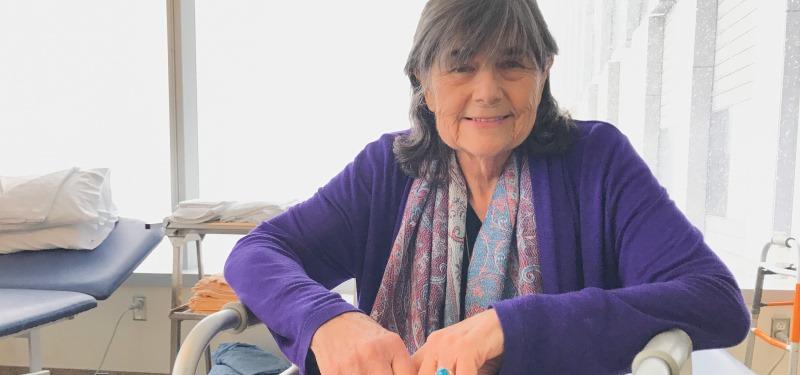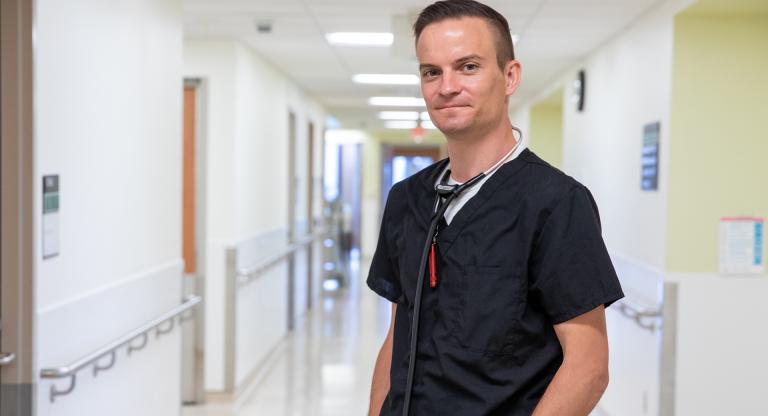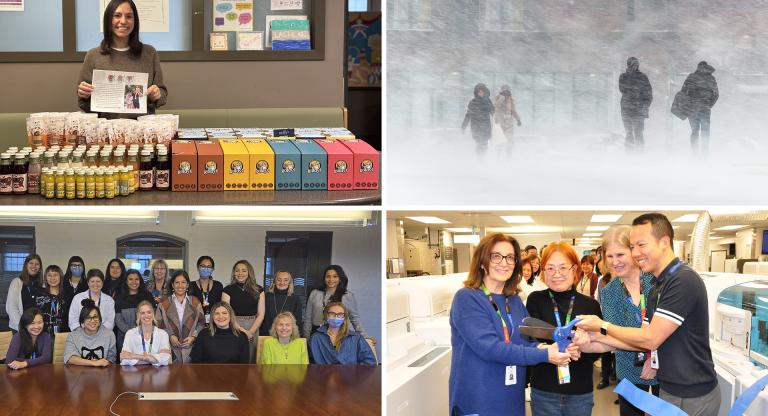Providing a smooth journey on the hip fracture pathway

In early February, Mrs. Penn was admitted to Bridgepoint for rehabilitation after surgery for a hip fracture.
“The people here have been absolutely fantastic. Everyone is attentive, considerate and encouraging. I appreciate the facility. It’s beautiful and clean.” Mrs. Penn says she’s felt motivated to make extra efforts, going for walks three to four times a day, including in the morning before breakfast.
“You have to be courageous. I had some options. I know I could have fallen apart, or I could take the high road and be courageous.” Mrs. Penn’s ready to return home where she’ll continue doing exercises with assistance from a Personal Support Worker.
Wartraud Erler was travelling home late one night from her regular volunteer work when she made a kind gesture that changed her life. She offered a young couple her seat on the subway so that they could sit together. The moment she got up to move, the stopping motion of the train threw her off balance and she fell, fracturing her hip. Wartraud was unable to move and lay on the cold floor of the subway while first responders determined the best way to transfer her into an ambulance. “I was in such pain, I felt I couldn’t breathe. I couldn’t think,” she says.
Wartraud was taken to the Emergency Department at Mount Sinai Hospital where she began a care journey on Sinai Health System’s hip fracture pathway. The pathway helps streamline care for patients with hip fractures from their arrival in the acute care hospital, through surgery, and then through rehabilitation at Bridgepoint Active Healthcare.
Common but complex
A hip fracture affects the upper part of the femur or thigh bone—the largest bone in the human body. Patients experience intense pain and often can’t move or even sit up until the fracture has been surgically repaired. Hip fracture surgery is the most common urgently performed procedure in Canada, with approximately 30,000 surgeries each year.

In addition to being common, one of the challenges for acute care hospitals is that hip fracture cases are also complex. “Our hip fracture patients are part of a vulnerable population – they are typically older adults who may be medically complex and frail, with a high risk of complications,” says Dr. Christine Soong, Chief of the Division of Hospital Medicine at Sinai Health System.
Dr. Soong is one of the quality improvement leads in creating the hip fracture pathway to improve outcomes for patients with a hip fracture. “We brought together the team on the Orthopaedic Surgery Unit to see how we could optimize care, which was quite fragmented at the time we started,” says Christine. We included surgeons, nurses, hospitalists, rehabilitation therapists, anesthesiologists, geriatricians, pharmacists, and social workers. What resulted was a dream team – much of the work was driven by front-line staff, who have transformed the care for these patients.”
Improving wait times and length of stay
Wartraud’s experience is an example of how the quality improvement project has paid off. Despite arriving in the Emergency Department late at night, she was scheduled for surgery the next morning. Wartraud says after everything she had been through, and the pain she experienced, getting to surgery quickly and being able to continue with the healing process “felt like a necessity.” Thanks to the excellent care she received, three days after surgery, Wartraud was ready to transfer to an inpatient rehabilitation hospital.
Wartraud’s journey is not unusual at Mount Sinai. In 2017 Dr. Soong and colleagues published a study that showed their quality improvement project had reduced the average time to surgery by 16.3 hours. Since then, they have further reduced the overall length of stay for patients with hip fracture to under 5 days, making Mount Sinai a top performer in optimizing care for hip fracture patients in Ontario.
Seamless care transitions
Mount Sinai and Bridgepoint’s amalgamation in 2015 means the hip fracture pathway that starts in the Emergency Department at Mount Sinai now continues to rehabilitation at Bridgepoint, all under Sinai Health System.
Wartraud says she was impressed by how smoothly her transfer went. “The move from Mount Sinai to Bridgepoint was very well organized, employees at Bridgepoint were very well prepared. There was good communication and it was a very pleasant process,” she says.
Doreen Watts, Patient Care Manager on the unit says the close collaboration between Mount Sinai and Bridgepoint has led to enhanced care and a better experience. “Since Bridgepoint and Mount Sinai Hospital joined together, we’ve created a more seamless transition. For example, we have improved the way we communicate about pain management. For this patient population, it’s particularly important that pain is well-managed across care transitions so that patients are comfortable to continue their therapy right away when they arrive on the unit.”
Patient-centred care

At Bridgepoint, the interprofessional care team works to ensure each patient’s journey on the hip fracture pathway continues smoothly. “Our unit has a patient-centred model of care that fosters collaboration between patients, families and the care team,” says Doreen. “During the admission process the patient, in partnership with a team member discusses goals and priorities for their rehabilitation. This way we all know what we’re working towards and we can track the patient’s progress to ensure we’re providing the best care that is tailored to their individual needs and priorities.”
Wartraud was able to start her physiotherapy soon after she arrived and although it was hard work, she says she felt the support of her care team. “There is one leg exercise that I had problems with and the physiotherapist helped me to make an adjustment so that I could do it. It’s amazing how these simple exercises have helped me to improve,” she says. “The employees also help to bring a bit of humour to the process. They have a way of making it fun. It doesn’t feel like pure exercise. The experience will stay in my memory.”
By the time she was ready for discharge, Wartraud was able to walk with a walker. Her care team helped her arrange to continue her rehabilitation at Bridgepoint in the outpatient program. Wartraud says she’s looking forward to getting back home and continuing with the exercises she’s learned. Her goal now is to be able to switch from using a walker to using a cane.
Continuing to improve
Jackie Eli, Senior Director, Rehabilitation and Ambulatory Care notes that Sinai Health System is continuing to build on this successful pathway. “Since the launch of the integrated hip fracture pathway we have been continuing to ask for ideas and feedback on how to refine and improve the patient and family experience during recovery and transitions,” she says. “The success of this project has created opportunities for the team involved to share their learning with colleagues to inform the creation of other quality improvement projects and the development of new clinical pathways.”












